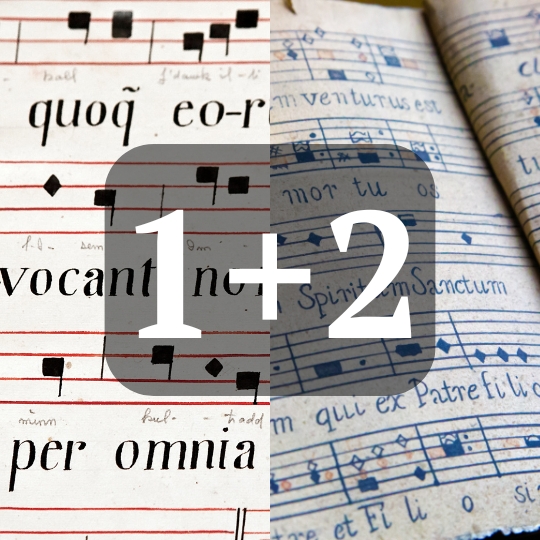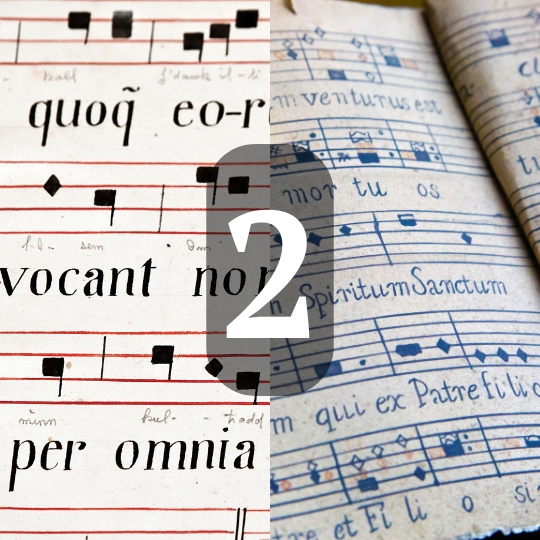Combining 1st and 2nd species counterpoint is where we truly start to unlock counterpoint’s potential as a tool for enhancing our composition skills. At this stage, we move beyond simple exercises and begin to engage in real composition. In 1st and 2nd species, or any species up to florid (5th species) counterpoint, we aren’t fully composing; we’re constrained by the rules of placing note or notes against a note. However, when we combine these initial species, we shift into true compositional work. Combining 1st and 2nd species not only emphasises harmonic intervals, voice leading, and melodic motion but also integrates the essential element of rhythm into the process.

Only one book I’ve studied has ever encouraged the combining of 1st and 2nd species counterpoint: Owen Swindale’s Polyphonic Composition (Amazon US, Amazon UK, Internet Archive), which happens to be my favourite book on the subject. My fondness for it likely stems from the fact that it introduces this mixing of species so early in the learning process. Many counterpoint books are uninspiring, bogged down in rules with little focus on practical application. As I mentioned earlier, combining 1st and 2nd species doesn’t just teach or demonstrate how counterpoint can be used in composition; it allows you to experience it early in your studies, keeping you engaged. Keeping things aligned with composition, this is why I incorporate this approach just before the halfway point of my course, 30 Days of Counterpoint.
In this article, I’ll share insights from my course, 30 Days of Counterpoint, specifically focusing on the lesson that combines 1st and 2nd species counterpoint. Naturally, this lesson builds on the foundational understanding of 1st and 2nd species counterpoint, so I recommend reviewing my articles on those topics first. Of course, I would actually suggest taking my full course, but that decision is yours to make. If you're short on time and can’t go through the previous articles in detail, here are some key principles to help you grasp the concepts discussed in this article:
1st and 2nd Species Counterpoint Rules Summarised
1st Species Counterpoint Summary
- 1 note in your counterpoint against 1 note in the given melody (cantus firmus/canto fermo)
- Consonances only
- Parallel motion between (or similar motion into) a perfect consonance is to be avoided
- Focus on imperfect consonances in the middle of your counterpoint
- Contrary motion is King
- Stepwise movement should form the bulk of the counterpoint. However, occasional leaps of 3rds, Perfect-4ths and 5ths, Minor-6ths and the octave are fine.
2nd Species Counterpoint
- 2 notes in your counterpoint against 1 note in the given melody
- Thesis (accented note) is the first note of each bar; Arsis (unaccented note) is the second
- Thesis must always be consonant (essentially following the rules of 1st species)
- Arsis can be consonant or dissonant
- Dissonances must be approached and left by step
- Consonances can be leapt between following the rules laid out in the 1st species
These rules remain the same in 1st and 2nd species counterpoint combined.
Les Biches (RM25-6) – Francis Poulenc
How to Write Fourth Species Counterpoint: A Comprehensive Guide
How to Write Third Species Counterpoint: A Comprehensive Guide
How to Write Second Species Counterpoint: A Comprehensive Guide
How to Write First Species Counterpoint: A Comprehensive Guide
Making Mozart Scary
1. Complementing Rhythms: The Foundation of Combined Counterpoint
In combined 1st and 2nd species counterpoint, the primary building blocks are typically semibreves and minims, making rhythmic balance between the parts essential. The key principle here is that when one part moves, the other should often (though not always) remain stationary. This complementary movement—where one line moves while the other holds—allows each voice to maintain its independence while contributing to a cohesive overall texture and harmonious sound.
Practical Application:
- Listen and Observe: As you write, pay close attention to how the two lines interact. Often, you'll notice that the upper voice (counterpoint) moves while the cantus firmus holds, or vice versa. This rhythmic interplay is what gives combined species counterpoint its clarity and effectiveness.
- Rhythmic Reduction: A helpful technique is to create a rhythmic reduction of your counterpoint, removing the pitches to focus solely on the rhythms. This allows you to see where the rhythms align and where they contrast, ensuring that the two voices complement each other effectively. If your counterpoint looks rhythmically too simple when reduced, consider revising it so that one voice plays semibreves while the other plays minims.
2. Cadences: Flexibility with First or Second Species
Cadences are crucial in bringing your counterpoint to a satisfying close. In combined 1st and 2nd species counterpoint, you have the flexibility to use either a 1st or 2nd species approach to cadence, each offering its own benefits.
First Species Cadence:
- The approach is more straightforward, with the final note approached by a 6th, that steps outward in both parts to an octave.
Second Species Cadence:
- The second species allows for more melodic movement leading into the cadence, often using a 5-6-8 progression that adds a layer of complexity and interest.
Nocturne No. 19 in E-Minor, Op. 72 No. 1 (Analysis) – Friederich Chopin
Wolfgang Amadeus Mozart – K. 304, K. 448 & k. 550: varying repetitions – bitesize Composition analysis
Aaron Copland – “Simple Gifts” (Appalachian Spring / Ballet for Martha) – Bitesize Music Composition Analysis
How to Write Second Species Counterpoint: A Comprehensive Guide
Walking Distance (The Twilight zone: S1, E5) – Bernard Herrmann – Part 1: Instrumentation & Orchestration
Bizet – Guiraud – Farandole from L’Arlesienne Suite No. 2 (Bitesize Composition Analysis)
3. Leaping from a Dissonance: Rules and Exceptions
Handling dissonance is always a delicate task in counterpoint. In 2nd species counterpoint, a fundamental rule is that dissonances must be approached and resolved by step. However, when combining species, there is an important exception: if the part leaping from a dissonance is in 1st species and it wasn’t the part that created the dissonance, the leap is permissible. On the other hand, if either or both parts are in 2nd species, then the parts in 2nd species must approach and resolve the dissonance by step.
In 2nd species studies, the occurrence of a 1st species part leaping out of a dissonance happens naturally. Typically, this part is the cantus firmus, so our focus is usually on the counterpoint we are writing. However, in combined 1st and 2nd species, whether a cantus firmus is used or not, it's crucial to pay attention to any minims that form a dissonance on the arsis (the second, unaccented beat) and how these minims resolve to the next accented note.
Common Pitfalls Summarised:
- Incorrectly Treated Dissonance: If both parts are in 2nd species and one or both leaps from a dissonance, this is incorrect. A dissonance formed by a minim on the arsis must resolve by step to a consonance.
- Correct Application: If the dissonance is created by the part in 2nd species, the 1st species part may leap freely, provided all other counterpoint rules are observed.
Conclusion
Combining 1st and 2nd species counterpoint serves as a pivotal step in transitioning from theoretical exercises to genuine composition. 1st and 2nd species combined not only enriches your understanding of harmonic intervals, voice leading, and melodic motion but also introduces the vital element of rhythm into your work. By mastering the principles of complementing rhythms, employing flexible cadential strategies, and adeptly handling dissonances, you lay a robust foundation for more advanced contrapuntal techniques.
As you continue your journey in counterpoint, remember that the interplay between independence and cohesion in your musical lines is key to creating compelling compositions. Practice diligently, listen critically, and don't hesitate to revisit foundational concepts to refine your skills further. Whether you choose to explore these techniques through additional articles or by enrolling in courses like 30 Days of Counterpoint, the knowledge you gain will be invaluable in your development as a composer.











